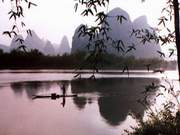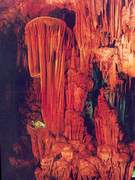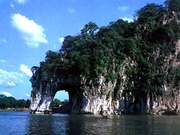|
Guilin
Located in south central
China in Guangxi Zhuang Autonomous Region, the city is
considered the most picturesque in China. Solitary
water-scarred limestone mountains rise out of the green plain,
their peaks hidden in swirling mists of low-lying clouds. The
city has been a favorite subject of painters and photographers for
centuries.
Cruising the Lijiang River
 By
cruising to Yangshuo from Guilin for 83 kilometers, one can
fully enjoy the charming beauty of the landscape, the green
mountains, limpid waters, dazzling stalactites and
stalagmites. Along the river, one can also appreciate
spectacular deep pools, dangerous shoals, murmuring springs
and waterfalls. There is a popular saying that the mountains
and waters of Guilin are the best under heaven.
By
cruising to Yangshuo from Guilin for 83 kilometers, one can
fully enjoy the charming beauty of the landscape, the green
mountains, limpid waters, dazzling stalactites and
stalagmites. Along the river, one can also appreciate
spectacular deep pools, dangerous shoals, murmuring springs
and waterfalls. There is a popular saying that the mountains
and waters of Guilin are the best under heaven.
Seven-Star Cave
Halfway up the western
slope of Putuo Mountain in Guilin City, the Seven-Star Cave
has three layers. The upper one is roughly 8-12 meters higher
than the middle one, but the latter abounds with splendid
scenic spots.
 Reed-Flute
Cave Reed-Flute
Cave
Situated at the south-foot
of Guangming Hill, the cave is huge and fantastic, eroded out
of karst formation. It is lined along its entire 500-meter
zigzagging length with stalactites and stalagmites. Beautiful,
colorful, and fantastic, the cave has been widely acclaimed as
an "Art Gallery of Nature".
Yangshuo
Located 65 kilometers
southeast of Guilin City, and surrounded by 10 peaks, Yangshuo
looks like a green lotus. Houses are dotted among the rows of
mountain peaks. The scenery here is reputed to be Guilin's
best.
 Elephant Trunk
Hill Elephant Trunk
Hill
At the confluence of the
Lijiang River and the Yangjiang River, a rock hill with a hole
in it gives the rock itself the appearance of an elephant
sipping water with its trunk; hence the name. Between the
trunk and the body, there is a round-shaped space, known as
the water-moon arch.
Piled Festoon Hill
Located by the Lijiang
River north of Guilin City, the hill is broken on all sides
with its strata exposed like decorative chains or strips;
hence the name. As there is an opening halfway up the Crane
Peak, the wind blows all year round. For this it is also known
as the "Windy Cave Hill." | 